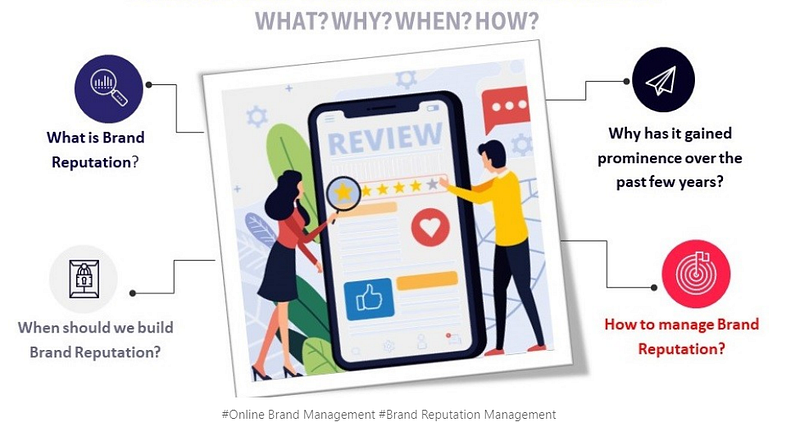

Brand Reputation Management
By Rowena Fernandes, ‘Challenging Stereotypes.’

First let’s start with the basics…What is a Brand?
Brand is a symbol, mark, logo, name, word or sentence that a company uses to distinguish their products and services from those of the competitors. These brand names/logos are protected legally through trademarks — this is the first and most important step in Brand Protection.
Assuming you have created a Brand and had it legally registered; let’s now understand What is Brand Reputation?
In simple words, Brand Reputation is the perception consumers carry in his/her mind about the Brand. A perception can be formed about the quality of company’s product or service, sales support, grievance/query handling et al. Brand reputation is also defined as the degree to which the company’s brand promise is heard, understood and believed by the world.
A brand is no longer what we tell the consumers it is; rather it is what the consumers tell each other — Scott Cook
Now to the 2nd question, why has Brand Reputation gained prominence over the past few years?
While the top management leads, builds and manages reputation; brand reputation is owned by various stakeholders — employees, shareholders, legal, media, government. This ownership of a brand’s reputation by varied stakeholder is the one of the reasons why companies need to have “Brand Reputation Management SOPs”.

The second reason is Technology; which has led to real time news, mobile connectivity, content sharing in various social media. You would have experienced this first hand; when there is an unexpected incident “we first pull out our mobile to capture, record and share to the digital world”. Further India had the world’s second-largest internet population at over 483 million users in 2018. Of these, 390 million users accessed the internet via their mobile phones. Estimates suggest that this figure would reach over 500 million by 2023. (Source: https://www.statista.com).
The third and final reason is the loss of control over communication once it is made available in the digital space. Once the content is made available online, company loses control of the conversation and relies on fans, influencers & collaborators to steer conversations on their behalf.
How to manage Brand Reputation especially in this digital age?
Considering this scenario of real time unpredictability, mobile technology and ownership of reputation by varied stakeholders, it is imperative for a company to implement & manage its online reputation.
To explain this better, mentioned below is the case study on Aashirvaad (Atta) who had to protect its brand reputation when a dubious video went viral across Social Media in 2017. The video showed the atta (flour) dough being washed many times and the residue produced was misrepresented as plastic — but, it was gluten. The below ‘four-step proof by assertion model was used to address this issue:
Juncture 1: Interventions at source; one-on-one interactions via Digital Media: Identifying sources from where this news was emanating and tackling the conversation it was triggering right at source.
Juncture 2: Platform alert and remedy — legal voice across Media: Won an injunction from the court against broadcasting of all malicious videos, prohibited people from publishing, circulating, sharing or communicating them in any manner. This helped in the removal of all defamatory content.
Juncture 3: Unbiased endorsement — expert voice through TV, digital and print: Pushed the truth across media channels and countered fake news using verification by experts; as end consumer would trust an expert over any other person.
Juncture 4: Reassurance media outreach — brand voice through TV, digital and print: Finally, the fake news was countered by massive brand voice counter-campaign, with a special focus on severely affected regions across the country (Source: WARC)
Today staying silent to fake news is no longer an option — remember it’s the negative / unexpected content that get viral most often than positive content. A lie told repeatedly can be perceived as the truth and once firmly embedded in consumer minds, it cannot be dislodged.
Now that we realized the criticality of Online Reputation Management, how do we proceed? The answer is to be proactive and not reactive.
We have seen enough reactive crisis management examples of how Cadbury (worms in dairy milk chocolate) and Nestle Maggi (lead content in instant noodles) suffered huge losses/backlash and how they had to use massive advertising campaigns to inform consumers on the corrective actions taken to re-build trust with all its stakeholders.
Being proactive is to empower employees with the skills, mindset and tools to actively look out for possible risks or challenges and turn it into an opportunity to build trust & goodwill for the organization.
Mentioned below is a framework to guide you to create & implement an Online Reputation Management System and successfully manage a crisis in this 21st century.
1. Create a culture that adopts Proactive mindset, empowers your team to take initiatives and seek out opportunities to build rapport/trust with the stakeholders. What is the one thing you can proactively do today to minimize the current risk right now? In short, Look, Listen, Learn.
2. Know your stakeholders — Where they are? What devices do they use in their daily lives? Where do they prefer to consume their media? What are they talking about?
3. Let technology work for you — collaborate with technology companies, influencers, Advertising agency to create brand stories that provoke conversations and develop deeper emotional connections
4. Have a system for managing the various stages in Crisis Management (refer to below image)

Remember the objective of Brand Reputation Management is to proactively build a reservoir of positive experience or credits to your Brand Bank account every single day. So that in case of an unexpected crisis you can use your credits to enjoy “a benefit of trust” in the minds of your stakeholders. Like every good bank account ensure that your credits always exceed your debits.
Airbnb is a great example to illustrate the above point. During the recent May 2020 layoffs; Airbnb's CEO Brain Chesky sent an email to the entire organization which communicated the reasons of Layoff and how the company will continue to support those who are laid off?
To conclude, every crisis provides us an opportunity to rebuild trust/reputation. However, I hope that after reading this article you will proactively build your brand reputation every day and thus be prepared for any worst-case scenario or unexpected crisis.
Author
Rowena Fernandes
Editor
Mridula Saravanan
We at CaratLane are solving some of the most intriguing challenges to make our mark in the relatively uncharted omnichannel jewellery industry. If you are interested in tackling such obstacles, feel free to drop your updated resume/CV to careers@caratlane.com!

Leave a Reply